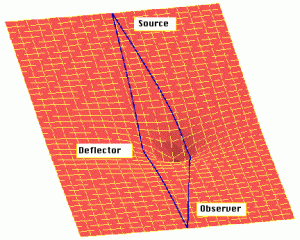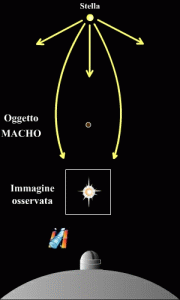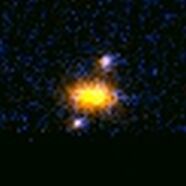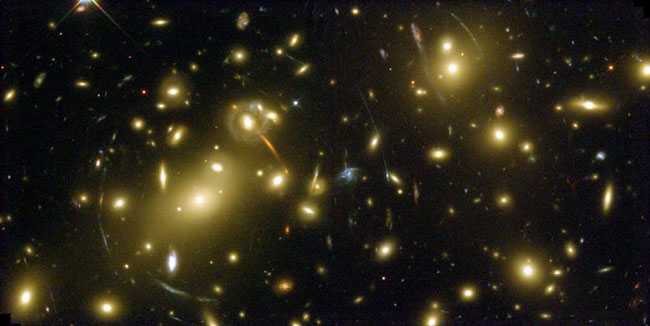How do we know it exists? (continued)
- Gravitational lenses. Galaxies. The term
gravitational lens
 indicates an effect, described in
General Relativity
indicates an effect, described in
General Relativity ,
according to which photons emitted by a light source, when passing near a very massive celestial body,
are affected by its
gravitational attraction.
,
according to which photons emitted by a light source, when passing near a very massive celestial body,
are affected by its
gravitational attraction.
 Close to this body,
space-time is modified and it becomes curved. This perturbation translates into a change in
the light path compared to the
original route; this gives rise to the formation of multiple images of the astronomic source (see left). Therefore, massive
celestial bodies act like gravitational lenses.
Close to this body,
space-time is modified and it becomes curved. This perturbation translates into a change in
the light path compared to the
original route; this gives rise to the formation of multiple images of the astronomic source (see left). Therefore, massive
celestial bodies act like gravitational lenses.
When the gravitational lens is made up of a galaxy or a cluster
 of galaxies, the image of the source results in either one or more "point-objects"or large bright arches (Fig. 4 & 5).
By measuring the angle by which the light is bent or the degree of distorsion of the image, we can estimate the mass
of the lens (deflector). In most cases it has been found that this mass is much greater than that associated with visible matter.
of galaxies, the image of the source results in either one or more "point-objects"or large bright arches (Fig. 4 & 5).
By measuring the angle by which the light is bent or the degree of distorsion of the image, we can estimate the mass
of the lens (deflector). In most cases it has been found that this mass is much greater than that associated with visible matter.
|
|
|
|
|
Fig.
3: Double image to show effect of gravitational lens. The photo, taken by the
Hubble Space Telescope
(Credits: Kavan Ratnatunga (Carnegie Mellon Univ.) and NASA) |
Fig.
4: The Abell 2218 cluster of galaxies. This cluster is so dense and compact that light coming from very far away,
situated beyond the cluster in the direction of observation, is amplified and distorted in the form of luminous arches.
(Credits: NASA, Andrew Fruchter and the ERO Team [Sylvia Baggett (STScI), Richard Hook (ST-ECF), Zoltan Levay (STScI)] (STScI)) |
- Gravitational lenses. MACHO.
When the lens is made up of an astronomical body with a mass less than that of the sun (we talk
in this case of a microlens, and these celestial bodies are called
MACHO
 ),
as in the case of an isolated planet, for example, the angular separation of the images is too small to be able to see
the double image. However, if the source is fixed and the lens is moving in relation to the star, we can observe apparent
variations of luminosity in the light emitted by the source star: luminosity is best when the source, lens and observer are
all in line; luminosity is reduced (and this is the true luminosity) when the lense is moved out of line. By measuring
how much the light of the source has been amplified, we can "weigh" the non-visible object that generates the gravitational lens.
),
as in the case of an isolated planet, for example, the angular separation of the images is too small to be able to see
the double image. However, if the source is fixed and the lens is moving in relation to the star, we can observe apparent
variations of luminosity in the light emitted by the source star: luminosity is best when the source, lens and observer are
all in line; luminosity is reduced (and this is the true luminosity) when the lense is moved out of line. By measuring
how much the light of the source has been amplified, we can "weigh" the non-visible object that generates the gravitational lens.

Fig. 5: Artist's impression of a gravitational lens produced by a MACHO. Click on figure to see animation. (If you can't see it, download Flash Player [qui]).
(Credit: Davide Centomo, Dip. di Fisica Universitą di Bologna)There has been a systematic analysis of the light variations of the stars in the Grande Nube di Magellano, a small satellite galaxy in our Milky Way
 . In some cases,
light variations in the stars have been observed and interpreted as being due to lenses made up of invisible
objects with a mass similar to that of large planets which, by moving on the edge of our galaxy, intercept
the light of certain stars. A certain number of these bodies has been identified, but their mass and number
contribute only in a small way to dark matter
. In some cases,
light variations in the stars have been observed and interpreted as being due to lenses made up of invisible
objects with a mass similar to that of large planets which, by moving on the edge of our galaxy, intercept
the light of certain stars. A certain number of these bodies has been identified, but their mass and number
contribute only in a small way to dark matter .
.
Gravitational lenses help us to obtain information about the presence of non-visible matter located in specific
places, such as large planets,
black holes![]() ,
and galaxies. This dark matter should be of the same type as visible matter (ordinary matter,
baryonic matter
,
and galaxies. This dark matter should be of the same type as visible matter (ordinary matter,
baryonic matter![]() ).
).
|
|
(How do we know… - page 2 of 2)
< Back | |


